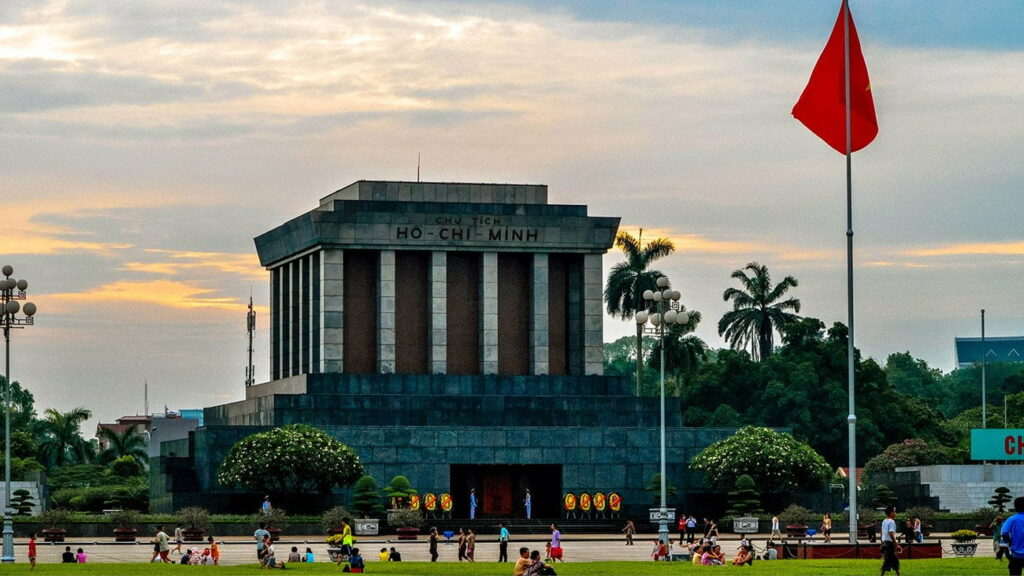Hanoi’s history can be separated into four eras: centuries of continual Chinese domination, a spell of French Colonialism, the Vietnam War and modern day Hanoi.
Perhaps one of the best ways to appreciate a city’s character is to understand its history. And what better way to understand a city’s history than by visiting its remnants?
Before going on a journey through Hanoi’s buildings and historical sites, it’s important to note that the land’s inhabitants can be traced back to around 3000 BC. One of the first known settlements is said to be the Co Loa Citadel (est. 257 BC), which is located about 20 km north of today’s Hanoi.
For those who are archeologically inclined, the site of the fortress is easily reached by either bus or train. There is a free museum which provides a historic overview of the area, two temples, ancient earthen walls and a few tombs. It is generally a bit off the beaten track and therefore not tremendously popular with tourists. There are no sleeping facilities but food is available not far from the citadel, as is the opportunity to visit surrounding villages.
Technically, therefore, when Hanoi took to the streets to celebrate its thousandth anniversary in 2010, it should have been celebrating its 4000 years of existence. Formalities aside, Hanoi’s first milestone is marked sometime in 1010, when Ly Cong Uan, the King of the first-ever powerful Vietnamese-led Dynasty, established the city as the imperial capital.
It was under Ly Cong Uan’s rule that the city oversaw the construction of the Confucius Temple of Literature in 1070. Six years later, the temple would go on to host the Imperial Academy, Vietnam’s first university, which was established to educate the Vietnamese elite, notably bureaucrats and nobility.
Despite years of war and disasters, this area of land has been able to preserve its architectural style for over a thousand years. Today, the place teems with revellers looking to find tranquillity in its quiet courtyards, ancient trees and neatly trimmed green lawns.
For most of the next 800 years the Chinese periodically invaded the area gradually causing the city’s decline. By 1802, the Vietnamese-led Nguyen Dynasty moved the imperial capital to Hue, making Hanoi a particularly easy target for French colonists. By 1887, only four years after the French occupation, Hanoi was made the capital of French Indochina.
At the time of invasion, the city consisted of only about 36 streets, most of which are now part of the Old Quarter. Each street specialised in a particular trade, whether it was silk, ceramics, jewellery or clothes. Throughout the years prior to the French occupation, it had gained a reputation as the business and trading hub of the Red River Delta. The historic Buddhist One Pillar Pagoda and one of the oldest surviving temples in Hanoi dating back to the 9th century, the Bach Ma Temple, are also found in the Old Quarter.
One of the most interesting architectural aspects of the Old Quarter is the way the houses have been shaped. For hundreds of years, King’s stipulated that citizens should not build higher than the height of the king’s palanquin. Given the dense population and small spread of land, people found that they needed to use the front of their houses as space for their stores. The inside of the house would be widened in length so as to make room for manufacturing, dining and living. These sort of short and narrow but extremely long tubular houses characterise the Old Quarter to this day still.
It is said that no era may have shaped Hanoi’s architecture more than the many years of French occupation. Naturally and gradually, and in typical French colonial fashion – wide, tree-line boulevards started to come into existence, giving name to the so-called French Quarter. There, one can find Trang Tien, a shop-lined street, known for its bookshops and jewellery stores. The Hanoi Opera House, built in 1911 and modelled after the famous Parisian Palais Garnier is also an important landmark. There are no tours of the opera house making it only possible to view the interior by visiting one of the plentiful performances.
Apart from the many beautiful colonial villas, once belonging to wealthy families, there is the opportunity to visit the Sofitel Legend Metropole Hanoi, arguably one of Hanoi’s most attractive pieces of colonial architecture. Charlie Chaplin is said to have spent his honeymoon in this hotel and Graham Greene had stayed here in the 50’s while writing The Quiet American.
It was during the 1950’s, after the Vietnamese had achieved independence, that the hotel was renamed Thong Nhat Hotel or Reunification Hotel by the Communist government. By the 1960s, the classical structure was being used as a bomb shelter to protect guests during the American air raids.
The Hoa Lo Prison, christened the Hanoi Hilton during the Vietnam War, is probably one of the most historically interesting, albeit infamous, places to see. It was first built by the French to incarcerate Vietnamese prisoners but was later used to hold American prisoners of war. Needless to say, it is hardly the place to experience that colonial grandeur and timeless elegance that you would if you were to see a ballet or theatre performance at the Hanoi Opera.
By 1954, French forces were eventually defeated by the Viet Minh and Hanoi became the capital of the newly established communist state of North Vietnam.
To understand what post-Imperialist, post-Colonialist and post-War Hanoi is today, it’s probably best to take the elevator to the 67th floor of the second tallest building in Southeast Asia, the Hanoi Lotte Centre and look at the city from there. You will be able to observe the monumental nature of the Brutalist-style Ho Chi Minh Museum and Mausoleum, the abundance of embassies now housed in yellow and white colonial houses, the rapid construction boom of the 21st Century and the everlasting tight streets that make up the labyrinth that is still the Old Quarter.
Vietnam’s geographical location has made it a place where people come to represent a mixture of races, languages and cultures. Hanoi’s history, much like the history of Vietnam, is turbulent and complex but the city’s architecture and in some cases the lack of it will always be able to speak for itself. It is through these buildings that we can understand Hanoi’s history at its best.







